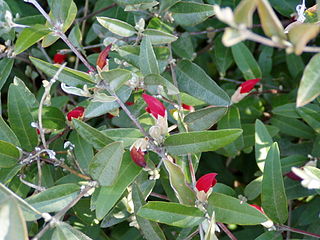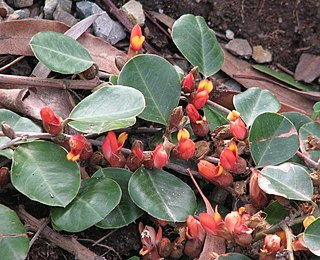
Gastrolobium is a genus of flowering plants in the family Fabaceae. There are over 100 species in this genus, and all but two are native to the south west region of Western Australia.

Alloxylon flammeum, commonly known as the Queensland tree waratah or red silky oak, is a medium-sized tree of the family Proteaceae found in the Queensland tropical rain forests of northeastern Australia. It has shiny green elliptical leaves up to 18 cm (7.2 in) long, and prominent orange-red inflorescences that appear from August to October, followed by rectangular woody seed pods that ripen in February and March. Juvenile plants have large deeply lobed pinnate leaves. Previously known as Oreocallis wickhamii, the initial specimen turned out to be a different species to the one cultivated and hence a new scientific name was required. Described formally by Peter Weston and Mike Crisp in 1991, A. flammeum was designated the type species of the genus Alloxylon. This genus contains the four species previously classified in Oreocallis that are found in Australasia.

Mirbelia is a plant genus belonging to the family Fabaceae. It is endemic to Australia, occurring in every mainland state except South Australia.

Gastrolobium melanopetalum is a shrub in the family Fabaceae which is endemic to the south-west of Western Australia.

Gastrolobium praemorsum is a scrambling shrub which is endemic to the south-west of Western Australia. It is a member of the family Fabaceae and produces red pea-flowers from late winter to early summer. It is not known whether this species shares the toxic properties of many other members of the genus Gastrolobium.

Gastrolobium bilobum, commonly known as heart-leaved poison, is a bushy shrub which is endemic to south west Western Australia.

Gastrolobium celsianum, also known as Swan River pea, is a low-growing shrub which is endemic to south-west of Western Australia.

Daviesia, commonly known as Bitter-peas, is a large genus of flowering plants in the legume family. They are native to Australia, with a centre of diversity in Western Australia.

Gastrolobium sericeum is a shrub in the family Fabaceae. It is endemic to the south-west of Western Australia.

Gastrolobium grandiflorum, commonly known as wallflower poison, wallflower poison bush or heart-leaf poison bush, is a bushy shrub which is endemic to Australia.
Gastrolobium spinosum, also known as prickly poison, is a shrub in the family Fabaceae. It is endemic to Southwest Australia
Gastrolobium propinquum is a shrub in the family Fabaceae, endemic to regions in Southwest Australia, which is toxic to many animals. It has been given the common name Hutt River poison.

Gastrolobium lehmannii or Cranbrook Pea is a vulnerable shrub in the family Fabaceae which is endemic to an area of Western Australia.

Gastrolobium minus, also known as broad-leaved brachysema, is a prostrate shrub which is endemic to the south-west of Western Australia. It is a member of the family Fabaceae and of the genus Gastrolobium, which contains many toxic species, however the toxicity of this species is unknown.

Persoonia stricta is a species of flowering plant in the family Proteaceae and is endemic to the south-west of Western Australia. It is an erect, spreading shrub with smooth bark, linear to spatula-shaped or oblong leaves, and bright yellow flowers borne in groups of four to twenty-five on a rachis 3–100 mm (0.12–3.94 in) long, each flower with a leaf or scale leaf at its base.

The Mirbelioids are an informal subdivision of the plant family Fabaceae that includes the former tribes Bossiaeeae and Mirbelieae. They are consistently recovered as a monophyletic clade in molecular phylogenies. The Mirbelioids arose 48.4 ± 1.3 million years ago. Members of this clade are mostly ericoid (sclerophyllous) shrubs with yellow and red flowers found in Australia, Tasmania, and Papua-New Guinea. The name of this clade is informal and is not assumed to have any particular taxonomic rank like the names authorized by the ICBN or the ICPN. Members of this clade exhibit unusual embryology compared to other legumes, either enlarged antipodal cells in the embryo sac or the production of multiple embryo sacs. There has been a shift from bee pollination to bird pollination several times in this clade. Mirbelioids produce quinolizidine alkaloids, but unlike most papilionoids, they do not produce isoflavones. Many of the Mirbelioids have pseudoraceme inflorescences.
Michael Douglas Crisp is an emeritus professor in the Research School of Biology at the Australian National University located in Canberra. In 1976 he gained a PhD from the University of Adelaide, studying long-term vegetation changes in arid zones of South Australia. Together with others he has revised various pea-flowered legume genera.

Gastrolobium formosum is a small, trailing shrub, with red flowers, in the pea family (Fabaceae), which grows up to a metre high, on clays and loam in swamps and along river banks. The inflorescence consists of head of four unstalked flowers which is sheathed by a whorl of large bracts, with the flower petals being obscured by the lower calyx lobes. The standard petal is less than on third the keel petal. It is native to the south-west of Western Australia.

Gastrolobium nervosum is a small shrub in the pea family (Fabaceae), native to Western Australia.

Gastrolobium villosum is a low spreading shrub in the pea family (Fabaceae), native to Western Australia. Like most Gastrolobiums it is poisonous to stock.

















